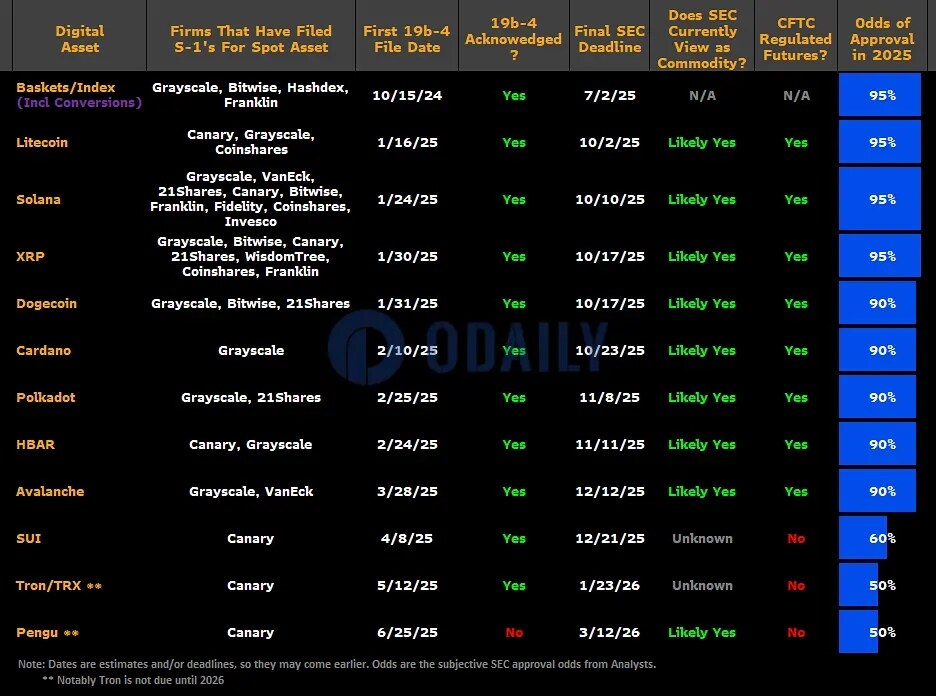Original | Odaily Planet Daily (@OdailyChina)

Yesterday, Bloomberg reported that Trump will sign an executive order on Thursday aimed at allowing private equity, real estate, cryptocurrency, and other alternative assets to be included in 401(k) retirement plans. This news has lifted the gloom brought on by tariffs, and the cryptocurrency market has shown strong performance. Bitcoin has strongly broken through the pressure level near $115,500, Ethereum is once again challenging the $4,000 mark, and the altcoin sector is buzzing. Is the long-awaited "altcoin season" finally coming?
What is a 401(k)? Why is the new policy significant?
The 401(k) plan is one of the most important retirement savings tools in the United States, managing about $9 trillion in assets and covering the retirement funds of tens of millions of Americans. As an employer-sponsored long-term savings plan, the 401(k) traditionally focuses on low-risk, high-liquidity assets such as stocks, bonds, and mutual funds, aiming to provide stable, long-term returns for retirees.
Trump's executive order directly tears apart this conservative framework—for the first time, it explicitly allows high-risk, high-return alternative assets to enter the 401(k) system, including cryptocurrencies, gold, private equity, and real estate. This means that in the future, trillions of dollars in retirement funds may flow into markets previously considered "non-mainstream," reshaping the investment landscape of American pensions. For further reading, see “Fierce Good News: Trump Plans to Open U.S. Retirement Funds to Cryptocurrency, Will Trillions Flow into the Market?”.
This is not the first time Trump has attempted to loosen the investment scope of 401(k). As early as 2020, his Department of Labor signaled the possibility of allowing 401(k) plans to access private assets, but due to the lack of presidential executive order backing, combined with the low liquidity and limited transparency of private assets, it ultimately failed to trigger widespread follow-up. This time, the new policy personally signed by the president not only has greater strength but also clearer execution determination.
In May 2025, the U.S. Department of Labor took the lead in rescinding the restrictive guidance on including cryptocurrencies in 401(k) plans that was established during the Biden administration, paving the way for this step. At the same time, the Federal Housing Finance Agency also required Fannie Mae and Freddie Mac to include borrowers' cryptocurrency holdings in the housing mortgage assessment system, indicating that the Trump administration is attempting to incorporate cryptocurrency assets into the mainstream of the U.S. economy on multiple levels.
Market estimates suggest that if 401(k) plans allocate just 2% of their assets to cryptocurrencies, it would mean an influx of about $170 billion—equivalent to two-thirds of the current market capitalization of existing cryptocurrency spot ETFs and listed reserves. Such a volume of funds is enough to make the entire cryptocurrency market boil.
However, the implementation of the policy will not yield immediate results. The executive order requires the Department of Labor and the U.S. Securities and Exchange Commission (SEC) to develop detailed regulatory rules and establish a "safe harbor" mechanism for 401(k) plan managers to reduce the legal risks they may face from offering high-risk assets. The establishment of a regulatory framework may take months or even years, and the investment ratios and specific asset ranges still need to be clarified. Nevertheless, its symbolic significance and potential impact are already enough to ignite the market's imagination.
State-level trials and institutional preemptive layouts
Before the federal policy is fully implemented, some state governments have already taken the lead in trialing.
North Carolina proposed the “North Carolina Digital Asset Investment Act” (House Bill 92) in March 2025, authorizing the state treasurer to invest up to 5% of the state public retirement fund in digital assets such as Bitcoin. Supporters of the bill, Republican Representative Mike Schietzelt, stated that this opens up a new asset class for the state's financial health. As of May 2025, the bill has passed the state House of Representatives and is still under review in the Senate.
Wisconsin and Michigan have also taken the lead. In May 2024, the Wisconsin Investment Board disclosed that it had purchased approximately $160 million worth of Bitcoin spot ETFs (mainly targeting BlackRock ETFs), accounting for 0.1% of its over $100 billion pension fund. Although it was reduced to $104 million in September, it has become a precedent for state-level pension allocation in cryptocurrency. Michigan disclosed in July 2024 that its pension fund purchased about $6.5 million in Bitcoin ETFs, included in the retirement investment portfolio for state government employees and teachers.
Arizona is also active. In February 2025, Republican State Senator Jake Hoffman proposed that the state retirement system consider allocating to Bitcoin ETFs.
Although these investment scales are not large, they are seen as signals of state-level pension "trial runs," providing reference samples for other states.
At the same time, Wall Street institutions are keenly capturing policy trends and accelerating layouts to seize the first-mover advantage in the 401(k) market. Fidelity Investments, an industry giant managing $5.9 trillion in assets, launched a retirement account product supporting cryptocurrencies in April 2024, allowing investors to invest in Bitcoin and Ethereum spot ETFs through self-directed brokerage accounts (SDB).
Blackstone President Jon Gray stated that leading institutions in the alternative asset field will be the first to benefit from the new 401(k) policy, expecting to attract hundreds of billions of dollars in inflows. Blackstone is collaborating with Morgan Stanley to develop private equity investment tools for 401(k) plans, lowering the entry threshold to attract small and medium investors. Apollo Global Management is partnering with State Street to launch target date funds (TDFs) that include private equity, specifically designed for retirement savings, balancing returns and risk control. BlackRock is also actively developing 401(k) products that support cryptocurrency spot ETFs and real estate investment trusts (REITs), with its digital asset head Robert Mitchnick stating that they are conducting in-depth research and education with pension fund managers to help them understand cryptocurrency asset investment.
These actions at the state and institutional levels indicate that whether through local policy experiments or Wall Street's strategic layouts, they are all paving the way for the inclusion of alternative assets in 401(k) plans. Cryptocurrencies, as a high-risk, high-return asset class, are gradually integrating into the U.S. retirement savings system.
Where will the funds flow? New opportunities in the cryptocurrency sector
The $9 trillion base of 401(k) assets has given the cryptocurrency market an unprecedented incremental imagination; even a small percentage of funds flowing in could significantly boost the prices of mainstream cryptocurrencies like Bitcoin and Ethereum. Especially, cryptocurrency spot ETFs, which have advantages in compliance, custody security, and liquidity, may become the first beneficiaries of this influx of funds.
Odaily Planet Daily previously discussed in “Where Will Institutional Money Flow? Unveiling the Five Golden Tracks of the Potential 'Altcoin Season'” that in the new funding cycle led by institutions, high liquidity and strong transparency targets are more likely to be favored. In addition to Bitcoin and Ethereum spot ETFs, projects like SOL, XRP, LTC, and DOGE also have a high probability of receiving ETF approvals, thus benefiting from this wave of retirement fund inflows.

Market controversies and risk warnings
Despite the market's enthusiasm, academia and regulators have expressed strong concerns about the high-risk characteristics of alternative assets.
Johns Hopkins University Professor Jeffrey Hooke bluntly stated that including private equity and cryptocurrencies in 401(k) is a "bad idea." He pointed out that private equity has poor liquidity and high costs, and long-term returns may not outperform traditional stock markets; while cryptocurrencies, due to their extreme volatility (for example, Bitcoin plummeted over 60% in 2022) and short history, are difficult to serve as a reliable choice for retirement savings.
Jerry Schlichter, a partner at Schlichter Bogard, a law firm specializing in high-fee 401(k) litigation, warned: "The retirement goals of ordinary people are safety and stability; cryptocurrencies are full of unknown risks, with severe short- to medium-term volatility, making them unsuitable as core retirement assets."
Democrats are also cautious about the policy. Senator Elizabeth Warren and others criticized the regulatory framework of the "Genius Act" as too lenient, fearing that allowing large companies to issue private cryptocurrencies could undermine the stability of the financial system. They described ordinary savers as potentially becoming "guinea pigs for policy experiments," calling for stricter regulations and risk assessments.
Conclusion
Trump's executive order is opening an unprecedented policy door for the cryptocurrency and alternative asset industries. If trillions of dollars in 401(k) funds flow in batches, it will not only change the direction of capital flow but also enhance the legitimacy and voice of cryptocurrency assets in the mainstream financial system.
However, opportunities come with risks. The formulation of regulatory details, the popularization of market education, and the setting of investment ratios will all determine the actual quality of this transformation. In the coming months, investors need to closely monitor the subsequent actions of the Department of Labor and the SEC, as well as the real pace of institutional fund deployment.
For the cryptocurrency market, this may not only be a feast of funds but also a critical turning point for cryptocurrency assets to truly step onto the mainstream financial stage.
免责声明:本文章仅代表作者个人观点,不代表本平台的立场和观点。本文章仅供信息分享,不构成对任何人的任何投资建议。用户与作者之间的任何争议,与本平台无关。如网页中刊载的文章或图片涉及侵权,请提供相关的权利证明和身份证明发送邮件到support@aicoin.com,本平台相关工作人员将会进行核查。



